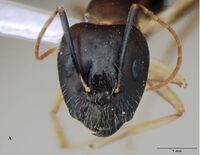Camponotus meghalayaensis
| Camponotus meghalayaensis | |
|---|---|

| |
| Scientific classification | |
| Kingdom: | Animalia |
| Phylum: | Arthropoda |
| Class: | Insecta |
| Order: | Hymenoptera |
| Family: | Formicidae |
| Subfamily: | Formicinae |
| Tribe: | Camponotini |
| Genus: | Camponotus |
| Species: | C. meghalayaensis |
| Binomial name | |
| Camponotus meghalayaensis Dhadwal & Bharti, 2023 | |
Workers of Camponotus meghalayaensis were collected moving around the house at the type locality (Nongpoh, India) and were observed entering a crack in the floor. The region has an average temperature of 30°C and has residential areas surrounded by forest.
Photo Gallery
Identification
Dhadwal & Bharti (2023) - The distinguishing characteristics of the species are as follows:
- the head is longer than broad
- the petiole node is thick and bluntly rounded
- the tibiae are compressed without spined beneath
- body is reticulate punctate, somewhat matte and sparsely pubescent
This species resembles Camponotus mitis and can be distinguished by the following combination of characters:
- C. meghalayaensis (major worker)
- the anterior clypeal margin is medially emarginated
- the body is covered with sparse erect hairs or less pilose and the node of petiole is thick and bluntly rounded in shape
- C. mitis (major worker)
- the anterior clypeal margin is not emarginated
- the body is covered with erect dense pilosity and the node of the petiole is thin and scale-like
Keys including this Species
Distribution
Latitudinal Distribution Pattern
Latitudinal Range: 25.9° to 25.9°.
| North Temperate |
North Subtropical |
Tropical | South Subtropical |
South Temperate |
- Source: Dhadwal & Bharti, 2023
Distribution based on Regional Taxon Lists
Oriental Region: India (type locality).
Distribution based on AntMaps
Distribution based on AntWeb specimens
Check data from AntWeb
Countries Occupied
| Number of countries occupied by this species based on AntWiki Regional Taxon Lists. In general, fewer countries occupied indicates a narrower range, while more countries indicates a more widespread species. |

|
Estimated Abundance
| Relative abundance based on number of AntMaps records per species (this species within the purple bar). Fewer records (to the left) indicates a less abundant/encountered species while more records (to the right) indicates more abundant/encountered species. |

|
Biology
Castes
Nomenclature
The following information is derived from Barry Bolton's Online Catalogue of the Ants of the World.
- meghalayaensis. Camponotus (Tanaemyrmex) meghalayaensis Dhadwal & Bharti, 2023d: 10, figs. 6-7 (s.w.) INDIA (Meghalaya).
- Type-material: holotype major worker, 6 paratype major and minor workers.
- Type-locality: holotype India: Meghalaya, Nongpoh, 25.9194°N, 91.8649°E, 475 m., 13.xi.2019 (T. Dhadwal); paratypes with same data.
- Type-depository: PUAC.
- Distribution: India.
Unless otherwise noted the text for the remainder of this section is reported from the publication that includes the original description.
Description
Worker
Major Holotype HL 2.58; HW 2.34; EL 0.59; SL 2.25; PW 1.23; WL 3.07; MTL 1.47; HTL 2.54; PL 0.69; PH 0.70; GL 2.33; TL 8.67; CI 83; SI 96; REL 22; PrI 52. Paratype (n = 1) - HL 2.66; HW 2.48; EL 0.61; SL 2.37; PW 1.35; WL 3.36; MTL 2.11; HTL 2.82; PL 0.77; PH 0.73; GL 2.46; TL 9.25; CI 107; SI 95; REL 22; PrI 54.
Habitus. In full-face view, head longer than broad (CI 83–107), posterior margin of the head rounded and shallowly concave in the middle, lateral margins slightly converging towards the anterior side; anterior clypeal margin medially emarginated; mandibles with 7 teeth; eyes large placed near the midlength of the head; antennae long, slender and 12-segmented; scape short (SI 95–96) surpassing posterior margin of the head by ¼ of its length. In dorsal view, mesosoma broad and elongated, pronotum anteriorly narrow (PrI 54); pro-mesonotal suture and metanotal groove distinct; mesosoma form a single convexity with mesonotum somewhat higher than the pronotum and propodeum in lateral view; propodeal declivity almost straight; propodeal spiracle oval in shape placed below the margin of propodeal declivity; petiole node is thick and bluntly rounded; tibiae compressed; gaster elongated.
Sculpture. Head and mesosoma reticulate punctate; head somewhat matte, whereas mesosoma and gaster are gleaming.
Pilosity and pubescence. Pubescence sparse, with a few setae present on the vertex and anterior margin of the clypeus; lateral sides of the head covered with sparse short erect hair; hind tibia densely setose, without a row of spiny bristles on ventral margin in addition to 3–4 suberect setae close to the apical spur.
Colouration. Head and gaster dark brown; mesosoma yellowish brown to reddish brown; legs lighter brown.
Minor Paratypes (n = 5) - HL 1.76–1.88; HW 1.02–1.11; EL 0.45–0.49; SL 2.29–2.41; PW 1.02–1.06; WL 2.66–2.82; MTL 1.80– 1.96; HTL 2.25–2.54; PL 0.57–0.65; PH 0.61–0.65; GL 2.29–2.58; TL 7.28–7.93; CI 57–59; SI 217– 224; REL 25–26; PrI 95–100.
Differs from the major worker in the following characteristics: head smaller and elongated (CI 57–59), longer than broad and narrower posteriorly than in the fornt, with the posterior margin almost rounded and sub-parallel lateral margins; anterior clypeal margin straight; eyes comparatively large touching the lateral sides of the head; mandibles with 6 teeth; scape distinctly long (SI 217–224) surpassing posterior margin of head by half of its length; mesosoma is shorter than the one of major worker.
Type Material
- Holotype: INDIA • major worker; Meghalaya, Nongpoh; 25.9194° N, 91.8649° E; elev. 475 m; 13 Nov. 2019; T. Dhadwal leg.; hand picking method; PUAC T51.
- Paratypes: INDIA • 6 workers; same collection data as for holotype; PUAC T55 to T60.
Etymology
The species has been named after the state Meghalaya, from where it was discovered.

